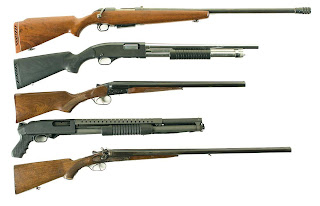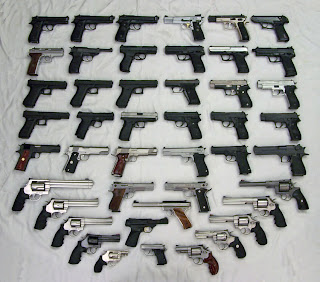One of the more popular firearms trends lately is the "tactical .22". These are rifles and pistols designed to look and function like full sized defensive firearms but chambered for the ever popular .22 long rifle cartridge. The advantage to these guns is a combination of low recoil and low cost while still mimicking the operation of a heavier caliber weapon. Prior to the recent "panic buying", the .22 LR round was one of the most popular, inexpensive, and easy to find calibers in the country. Unfortunately due to recent events, ammo has become scarce and the little .22 is no exception. Hopefully as things begin to return to normal we'll see availability of all ammunition begin to increase.
I recently acquired a Ruger SR22 .22 caliber semiautomatic pistol. Although technically the gun was used, the previous owner put less than 100 rounds through it so, for all intents and purposes, this was a new gun. The pistol arrived in the familiar white cardboard box emblazoned with the Ruger logo. Inside the box was the pistol, two 10-round magazines with two extended and two compact floorplates, two grips, an envelope containing a fired casing, a lock, a zippered carrying case, and an instruction manual.
Upon initial examination I observed that the fit and finish were very good, as expected from a major American firearms manufacturer. The pistol is equipped with striations on both the fore and rear sections of the lightweight aluminum slide. These help to facilitate chambering a round and press checking the chamber. Sights are the standard 3 dot configuration with a square notch in the rear. The rear sight is adjustable for both windage and elevation. The front is a fixed dovetail. The pistol also features a small picatinny rail on the underside of the frame just forward of the trigger guard. This will allow for the easy installation of a small light or laser sight. In typical .22 auto fashion, the SR22 is blowback operated and features a fixed stainless steel barrel. The barrel is removable by loosening a set screw and can be changed quite easily. Ruger offers an optional threaded barrel which is convenient for anyone who possesses an NFA registered .22 caliber suppressor.
One of the positive features of this gun is the option of two different grip configurations. One has a larger palm swell and fills the hand. Since my hands are large, this is the grip I chose. The other grip is slimmer and would be suited to persons with small hands, particularly petite women or children. Changing the grips is simple and requires no tools. First, make certain that the pistol is unloaded by removing the magazine, racking the slide and visually inspecting the chamber. Then, keeping the pistol pointed in a safe direction, simply grasp the grip and slide it down and off of the gun. To install the grip, simply reverse the process by sliding the grip onto the frame until it snaps into place.
Controls on the Ruger are also very straightforward. As a lefty, I appreciate both the ambidextrous safety and the ambidextrous magazine release button. The safety is frame mounted and also acts as a decocker. The magazine release is located just to the rear of the trigger guard as is common with a majority of modern auto pistols. The slide lock/release is located on the left side of the frame just forward of the safety. The slide is designed to lock open after firing the last round in a magazine which is a nice feature and one not always found on blowback .22 pistols. The SR22 is classified as a traditional double action/single action (DA/SA) pistol. This means that pulling the trigger with the hammer lowered both cocks and fires the pistol. After the pistol fires and cycles, the hammer remains cocked and all subsequent shots are fired in the single action mode. Engaging the safety will also decock the pistol, safely lowering the hammer. In addition to the frame mounted safety, the SR22 is also equipped with a magazine disconnect safety. This means that the pistol can not fire with the magazine removed, regardless of whether the hammer is cocked or not.
Field stripping the SR22 for cleaning and maintenance is also simple and straightforward and requires no tools. For disassembly, there is a take down lever located just forward of the trigger on the left hand side of the frame. To disassemble, first remove the magazine, rack the slide, and visually inspect the chamber to ensure the pistol is unloaded. Then rotate the take down lever all the way down. Pull the slide to the rear, lift up, and then move the slide forward off of the frame. You will then also be able to remove the recoil spring and recoil spring guide rod. As previously mentioned, the barrel is fixed and will remain attached to the frame. Reassembly is accomplished by simply reversing the process.
After unpacking and inspecting the pistol, I loaded up my range bag and headed to the local indoor range. I brought along two types of .22 ammo; Federal Champion 36 grain copper plated hollow points and Remington Golden Bullet 36 grain lead round nose hollow points. Beginning with the Federal, I loaded 10 rounds into both magazines and slow fired offhand unsuported at a bullseye target set at 15 yards. The initial point of impact was decidedly high and to the right. After some trial and error and adjustment, I was able to keep my rounds centered and in a reasonable sized group. All shots at this time were fired in the single action mode. During the course of firing the first forty or so rounds, I experienced two failures to feed (FTF). The pistol fired and cycled but failed to pick up a fresh round from the magazine. I attribute this to a new autopistol which will hopefully become more reliable as it gets broken in. Aside from these two hiccups, there were no further malfunctions experienced with either the Federal or the Remington loads. Time will tell.
The single action trigger pull was relatively light with just a hint of creep. The break of the trigger was acceptably crisp. The double action pull was not excessively heavy or difficult but there was just a little bit of a "gritty" feel to the trigger. I suspect that as the gun is broken in, the trigger pull will gradually get smoother. Overall, the double and single action trigger pulls of the SR22 are perfectly acceptable for this type of handgun. After firing several magazines in single action/slow fire mode, I wanted to test the gun in a more defensive manner. I placed a silhouette target at 7 yards and fired several double taps or controlled pairs, decocking the pistol each time so that the first shot was fired DA and the second was fired SA. The low recoil of the .22 round was a clear advantage here as the pistol's muzzle rose only slightly. Because of this, it was easy to fire rapid followup shots and to remain on target, even when firing three, four, or more rounds at a time.
Overall I found the Ruger SR22 to be a great little auto pistol. Fun and inexpensive to own and shoot, I recommend this gun to anyone looking to practice their defensive pistol skills without breaking the bank. Although most shooters agree that the .22 should not be one's first choice as a defensive pistol caliber, I would certainly not feel naked before my enemies armed with an SR22 loaded with 10 rounds of high velocity .22 hollow points. For a shooter who may be particularly sensitive to recoil, this little gun could fit their needs very nicely, and a .22 in the hand beats a .45 left at home every time. Stay safe.















